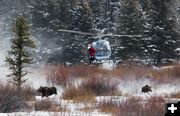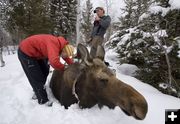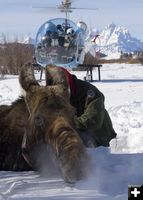

Darting moose from helicopter
Wyoming Game and Fish Wildlife Veterinarian, Terry Kreeger, prepares to shoot a tranquilizer dart in the rump of a cow moose near Moran earlier this winter. Photo by Mark Gocke, WGFD.
|


Looking for ticks
University of Wyoming graduate student, Scott Becker, talks to the helicopter pilot while fellow graduate student, Laura Linn, checks a cow moose for the presence of winter ticks. Photo by Mark Gocke, WGFD.
|


Moose Wake-Up Drug
Wyoming Game and Fish Wildlife Veterinarian, Cynthia Tate, administers the reversal drug to a tranquilized cow moose before jumping into the helicopter to handle the next downed moose. Photo by Mark Gocke, WGFD.
|
|
Researchers collar additional Moose near Jackson
by Wyoming Game & Fish
April 2, 2007
(Jackson) - Biologists from the Wyoming Game and Fish Department and University of Wyoming teamed up to capture and fit an additional 20 moose from the Jackson moose herd with radio collars, near Moran Junction earlier this winter.
This was an effort to replace 20 GPS (Global Positioning System) collars that automatically fell off the cow moose they were attached to on March 1st. These GPS collars are designed to self-deploy and fall to the ground after two years, so that researchers can recover them and download the data to their computer. Currently, there are a total of 52 collared moose being tracked in the Jackson herd, 16 bulls and 32 cows.
It's all part of a multi-year moose study designed to look at moose survival, calf production and habitat use. The Jackson herd, like other moose herds in northwest Wyoming, has been in decline for the past 12-15 years and wildlife managers hope this study will provide answers as to why.
Another aspect of the study is habitat selection and movements of moose adjacent to U.S. Highway 26/287, which is currently under construction in the Buffalo Valley area. The WY Department of Transportation (WYDOT) has contributed $50,000 to help make the study possible.
"WYDOT's primary goal with the GPS collars will be gaining information to help us evaluate moose movements relative to right-of-way fences, existing vegetation and clear zones," said WYDOT spokesman Cody Beers. "This moose movement study should help us learn about how moose use areas near highways, and we hope to gain valuable information about how the moose in Buffalo Valley react to this highway improvement project."
Moose were darted from a helicopter then approached by biologists on the ground as the immobilization drug took effect. Once immobilized, a number of tissue samples and data were collected to assess the animal's health. Blood, hair and fecal samples were collected for lab analysis. An ultrasound was also used to measure rump fat depth. By analyzing all of these indices, researchers will be able to estimate individual fitness and overall herd health.
Additional tasks included an examination of both tooth wear and the presence of ticks, which moose are highly susceptible to in late winter. Finally, each animal received ear tags and a radio collar to allow tracking of their movements. Once complete, a reversal drug was administered and the moose would return to their feet and their daily lives. The whole process would take approximately 15-20 minutes for each animal.
"Overall, the moose appeared to be in relatively good shape, although rump fat was slightly lower than the previous two years," said Scott Becker, University of Wyoming graduate student in charge of carrying out the study. "These animals put on their body fat during the summer and fall months and last summer was somewhat drier than the past two, which may explain the lower body fat."
"Having this many collared animals, of both sexes, should give us a more comprehensive look at the herd, while providing managers with important habitat selection information adjacent to the roadway," said Becker. "During the next phase, we will continue to monitor survival and reproduction while evaluating moose use of specific summer habitats, including the use of areas burned during the 1988 fires."
The Game and Fish has steadily reduced the number of hunting permits in the Jackson moose herd unit from a high of 495 in 1991, to just 55 in 2006. "To this point, our only tool to help this herd has been to reduce the hunting pressure, said Jackson Wildlife Biologist Doug Brimeyer. "We've been reducing the number of permits in the Teton Wilderness hunt areas for well over 10 years now, but the population has continued to decline."
"However, this past year we did see a slight increase in calf production with a greater occurrence of twinning, which is encouraging," said Brimeyer. "We saw this in adjacent moose herds as well. We're hoping it's the start of an upward trend for the herd."
A similar moose study is taking place in the Snowy Range west of Laramie, WY. This moose population is a relatively new to Wyoming, expanding into the Snowy Range from a moose introduction effort in northern Colorado. "They seem to have a thriving population down there, which is common for a herd that is pioneering into quality habitat," commented Brimeyer. "And it could be that our herd simply reached the habitat's carry capacity in the 1990s and then experienced lower reproduction and lower survival, all of which were likely made worse by the effects of predation."
Photos by Mark Gocke, Wyoming Game & Fish Department (WGFD)
|


